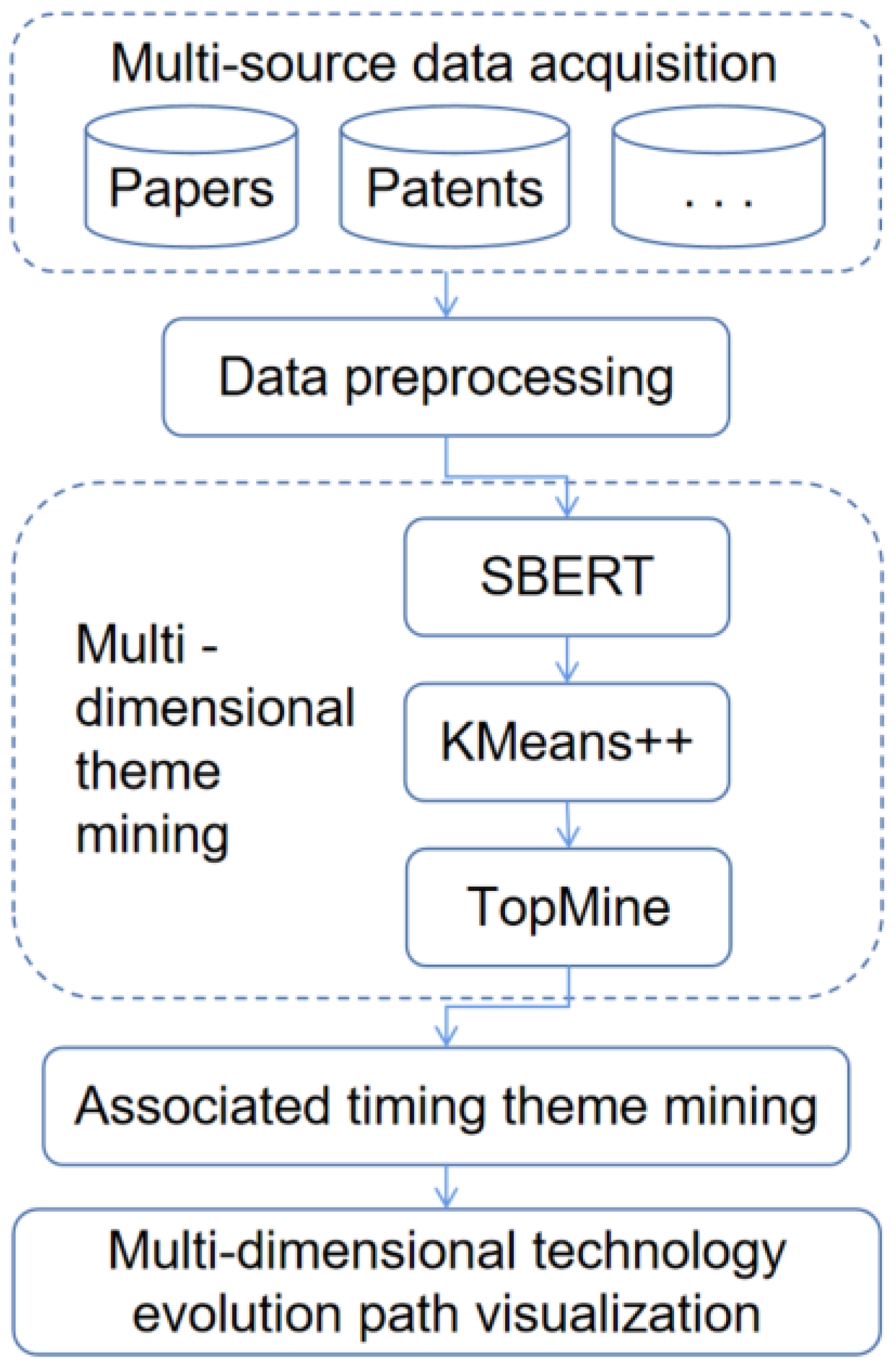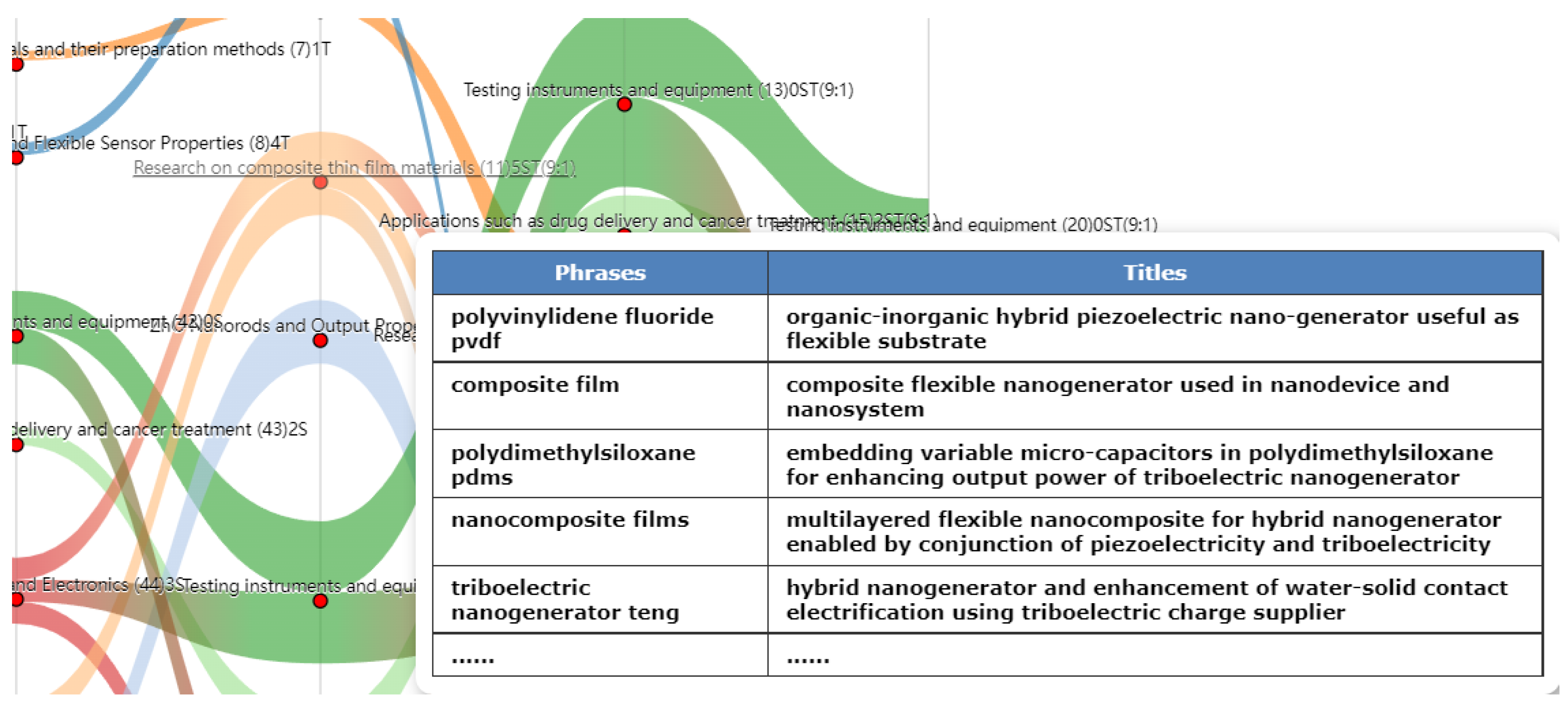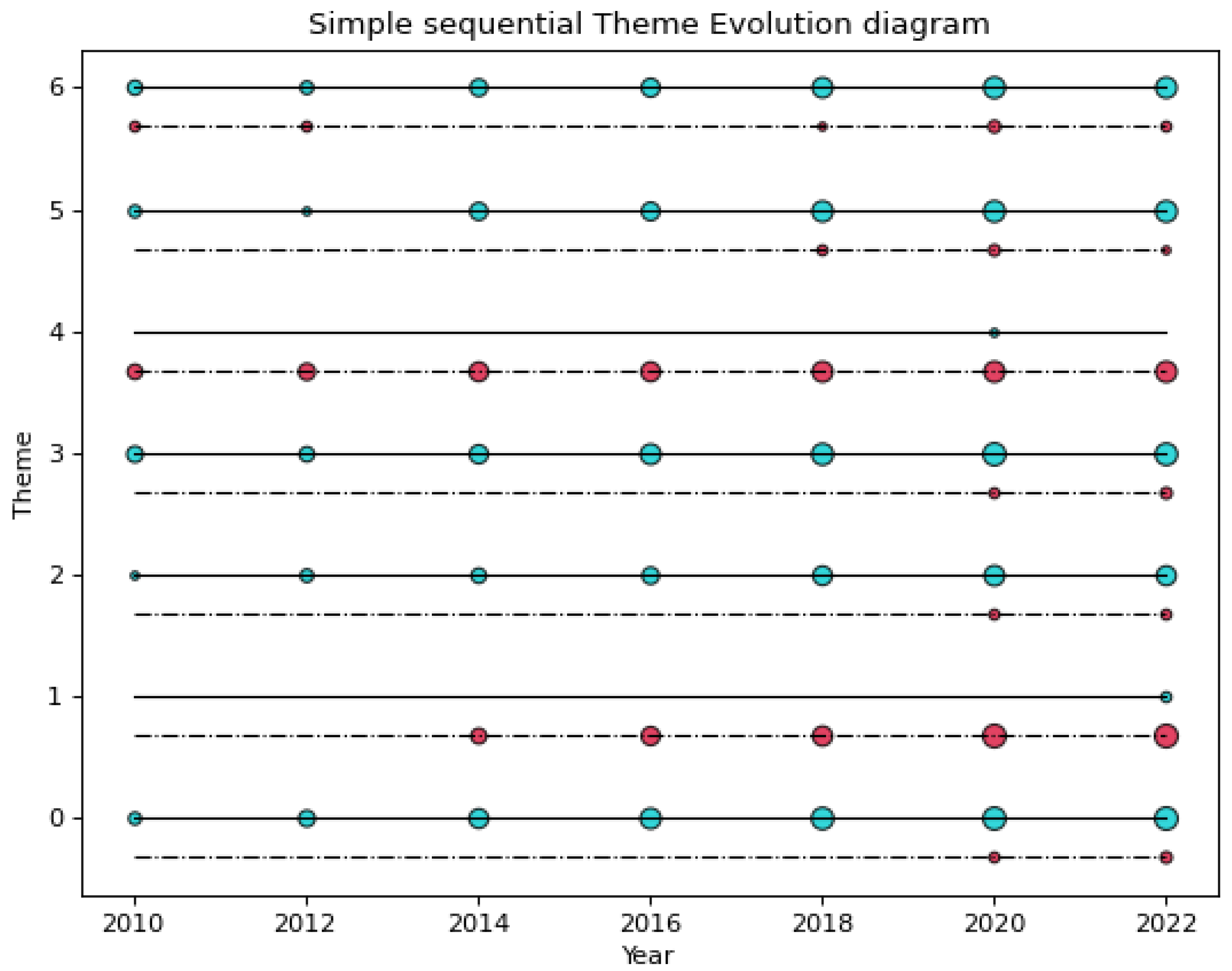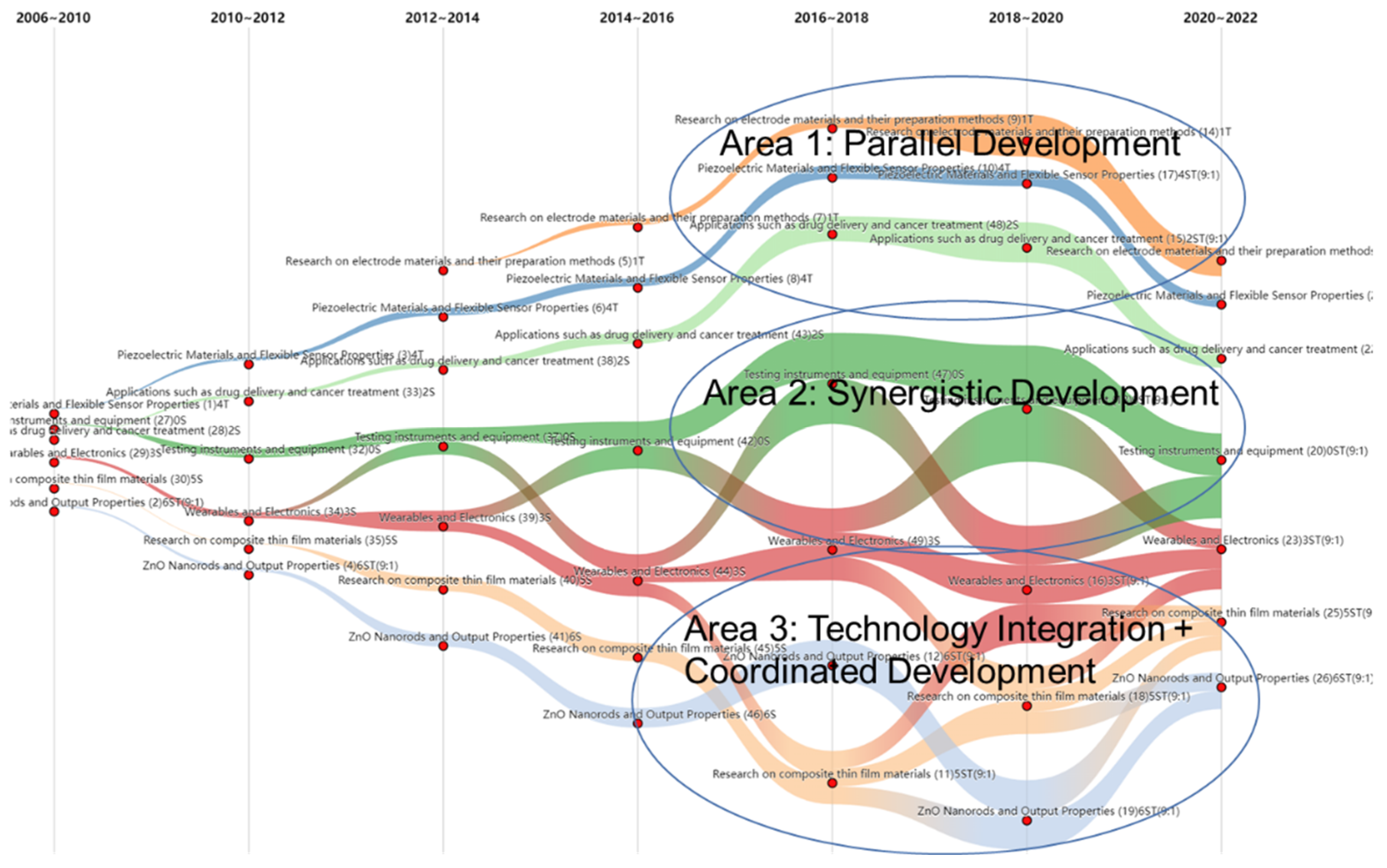Unveiling Evolutionary Path of Nanogenerator Technology: A Novel Method Based on Sentence-BERT
Abstract
:1. Introduction
2. Literature Review
2.1. Development of Nanogenerators
2.2. Technology Evolutionary Path
2.3. Research on Multi-Source Data and Text Mining
3. Methods
3.1. Data
3.2. Theme Modeling Based on Sentence-BERT
3.3. Unveiling Evolutionary Path Based on Associated Timing Theme
3.4. Visualization of Multi-Dimensional Technology Evolutionary Path
4. Experimental Results and Discussion
4.1. Multi-Source Theme Identification and Association
4.2. Visualization and Analysis of Multi-Dimensional Technology Evolutionary Path
5. Conclusions
Author Contributions
Funding
Institutional Review Board Statement
Informed Consent Statement
Data Availability Statement
Conflicts of Interest
References
- Cao, X.; Jie, Y.; Wang, N.; Wang, Z.L. Triboelectric Nanogenerators Driven Self-Powered Electrochemical Processes for Energy and Environmental Science. Adv. Energy Mater. 2016, 6, 1600665. [Google Scholar] [CrossRef]
- Wen, Z.; Shen, Q.; Sun, X. Nanogenerators for Self-Powered Gas Sensing. Nano-Micro Lett. 2017, 9, 45. [Google Scholar] [CrossRef]
- Fan, F.R.; Tang, W.; Wang, Z.L. Flexible Nanogenerators for Energy Harvesting and Self-Powered Electronics. Adv. Mater. 2016, 28, 4283–4305. [Google Scholar] [CrossRef]
- Bai, Y.; Jantunen, H.; Juuti, J. Energy Harvesting Research: The Road from Single Source to Multisource. Adv. Mater. 2018, 30, 1707271. [Google Scholar] [CrossRef]
- Chem, J.M.; Lee, J.; Kim, J.; Kim, Y.; Hossain, A.; Kim, S.; Ho, J. All-in-one energy harvesting and storage devices. J. Mater. Chem. A 2016, 4, 7983–7999. [Google Scholar]
- Zhang, Y.; Xie, M.; Adamaki, V.; Khanbareh, H.; Bowen, C.R. Control of electro-chemical processes using energy harvesting materials and devices. Chem. Soc. Rev. 2017, 46, 7757–7786. [Google Scholar] [CrossRef]
- Wu, C.; Wang, A.; Ding, W.; Guo, H.; Wang, Z.L. Triboelectric Nanogenerator: A Foundation of the Energy for the New Era. Adv. Energy Mater. 2018, 9, 1802906. [Google Scholar] [CrossRef]
- Lin, Z. Nanogenerators, self-powered systems, blue energy, piezotronics and piezo-phototronics—A recall on the original thoughts for coining these fields. Nano Energy 2018, 54, 477–483. [Google Scholar]
- Wang, B.; Liu, Y.; Zhou, Y.; Wen, Z. Emerging nanogenerator technology in China: A review and forecast using integrating bibliometrics, patent analysis and technology roadmapping methods. Nano Energy 2018, 46, 322–330. [Google Scholar] [CrossRef]
- Li, M.; Zhou, Y. Visualizing the knowledge profile on self-powered technology. Nano Energy 2018, 51, 250–259. [Google Scholar] [CrossRef]
- Azimi, S.; Golabchi, A.; Nekookar, A.; Rabbani, S.; Amiri, M.H.; Asadi, K.; Abolhasani, M.M. Self-powered cardiac pacemaker by piezoelectric polymer nanogenerator implant. Nano Energy 2021, 83, 105781. [Google Scholar] [CrossRef]
- Lee, S.; Wang, H.; Wang, J.; Shi, Q.; Yen, S.-C.; Thakor, N.V.; Lee, C. Battery-free neuromodulator for peripheral nerve direct stimulation. Nano Energy 2018, 50, 148–158. [Google Scholar] [CrossRef]
- Lee, S.; Wang, H.; Peh, W.Y.X.; He, T.; Yen, S.-C.; Thakor, N.V.; Lee, C. Mechano-neuromodulation of autonomic pelvic nerve for underactive bladder: A triboelectric neurostimulator integrated with flexible neural clip interface. Nano Energy 2019, 60, 449–456. [Google Scholar] [CrossRef]
- Hassani, F.A.; Mogan, R.P.; Gammad, G.G.L.; Wang, H.; Yen, S.-C.; Thakor, N.V.; Lee, C. Toward self-control systems for neurogenic underactive bladder: A triboelectric nanogenerator sensor integrated with a bistable micro-actuator. ACS Nano 2018, 12, 3487–3501. [Google Scholar] [CrossRef] [PubMed]
- Sultana, A.; Alam, M.; Garain, S.; Sinha, T.K.; Middya, T.R.; Mandal, D. An Effective Electrical Throughput from PANI Supplement ZnS Nanorods and PDMS-Based Flexible Piezoelectric Nanogenerator for Power up Portable Electronic Devices: An Alternative of MWCNT Filler. ACS Appl. Mater. Interfaces 2015, 7, 19091–19097. [Google Scholar] [CrossRef] [PubMed]
- Pu, X.; Guo, H.; Chen, J.; Wang, X.; Xi, Y.; Hu, C.; Wang, Z.L. Eye motion triggered self-powered mechnosensational communication system using triboelectric nanogenerator. Sci. Adv. 2017, 3, e1700694. [Google Scholar] [CrossRef]
- Ali, F.; Raza, W.; Li, X.; Gul, H.; Kim, K.-H. Piezoelectric energy harvesters for biomedical applications. Nano Energy 2019, 57, 879–902. [Google Scholar] [CrossRef]
- Liu, Z.; Li, H.; Shi, B.; Fan, Y.; Wang, Z.L.; Li, Z. Wearable and Implantable Triboelectric Nanogenerators. Adv. Funct. Mater. 2019, 29, 1808820. [Google Scholar] [CrossRef]
- Li, Z.; Zheng, Q.; Wang, Z.L.; Li, Z. Nanogenerator-based self-powered sensors for wearable and implantable electronics. Research 2020, 2020, 8710686. [Google Scholar] [CrossRef]
- Chen, J.; Oh, S.K.; Zou, H.; Shervin, S.; Wang, W.; Pouladi, S.; Zi, Y.; Wang, Z.L.; Ryou, J.H. High-Output Lead-Free Flexible Piezoelectric Generator Using Single-Crystalline GaN Thin Film. ACS Appl. Mater. Interfaces 2018, 10, 12839–12846. [Google Scholar] [CrossRef]
- He, X.; Zou, H.; Geng, Z.; Wang, X.; Ding, W.; Hu, F.; Zi, Y.; Xu, C.; Zhang, S.L.; Yu, H.; et al. A Hierarchically Nanostructured Cellulose Fiber-Based Triboelectric Nanogenerator for Self-Powered Healthcare Products. Adv. Funct. Mater. 2018, 28, 1805540.1–1805540.8. [Google Scholar] [CrossRef]
- Wang, X.; Song, J.; Liu, J.; Wang, Z.L. Direct-Current Nanogenerator Driven by Ultrasonic Waves. Science 2007, 316, 102–105. [Google Scholar] [CrossRef]
- Sahoo, R.; Mishra, S.; Unnikrishnan, L.; Mohanty, S.; Mahapatra, S.; Nayak, S.K.; Anwar, S.; Ramadoss, A. Enhanced dielectric and piezoelectric properties of Fe-doped ZnO/PVDF-TrFE composite films. Mater. Sci. Semicond. Process. 2020, 117, 105173. [Google Scholar] [CrossRef]
- Zhang, L.; Bai, S.; Su, C.; Zheng, Y.B.; Qin, Y.; Xu, C.; Wang, Z.L. A high-reliability kevlar fiber-ZnO nanowires hybrid nanogenerator and its application on self-powered UV detection. Adv. Funct. Mater. 2015, 25, 5794–5798. [Google Scholar] [CrossRef]
- Murillo, G.; Blanquer, A.; Vargas-Estevez, C.; Barrios, L.; Ibanez, E.; Nogues, C.; Esteve, J. Electromechanical nanogenerator-cell interaction modulates cell activity. Adv. Mater. 2017, 29, 1605048. [Google Scholar] [CrossRef] [PubMed]
- Zhao, Y.; Deng, P.; Nie, Y.; Wang, P.; Zhang, Y.; Xing, L.; Xue, X. Biomolecule-adsorption-dependent piezoelectric output of ZnO nanowire nanogenerator and its application as self-powered active biosensor. Biosens. Bioelectron. 2014, 57, 269–275. [Google Scholar] [CrossRef] [PubMed]
- Wang, Z.L. ZnO nanowire and nanobelt platform for nanotechnology. Mater. Sci. Eng. R 2009, 64, 33–71. [Google Scholar] [CrossRef]
- Hinchet, R.; Yoon, H.-J.; Ryu, H.; Kim, M.-K.; Choi, E.-K.; Kim, D.-S.; Kim, S.-W. Transcutaneous ultrasound energy harvesting using capacitive triboelectric technology. Science 2019, 365, 491–494. [Google Scholar] [CrossRef] [PubMed]
- Park, K.-I.; Son, J.H.; Hwang, G.-T.; Jeong, C.K.; Ryu, J.; Koo, M.; Choi, I.; Lee, S.H.; Byun, M.; Wang, Z.L.; et al. Highly-Efficient, Flexible Piezoelectric PZT Thin Film Nanogenerator on Plastic Substrates. Adv. Mater. 2014, 26, 2514–2520. [Google Scholar] [CrossRef]
- Liu, S.; Zou, D.; Yu, X.; Wang, Z.; Yang, Z. Transfer-free PZT thin films for flexible nanogenerators derived from a single-step modified sol-gel process on 2D mica. ACS Appl. Mater. Interfaces 2020, 12, 54991–54999. [Google Scholar] [CrossRef] [PubMed]
- Park, D.Y.; Joe, D.J.; Kim, D.H.; Park, H.; Han, J.H.; Jeong, C.K.; Park, H.; Park, J.G.; Joung, B.; Lee, K.J. Self-Powered Real-Time Arterial Pulse Monitoring Using Ultrathin Epidermal Piezoelectric Sensors. Adv. Mater. 2017, 29, 1702308. [Google Scholar] [CrossRef] [PubMed]
- Zhu, C.; Guo, D.; Ye, D.; Jiang, S.; Huang, Y. Flexible PZT-integrated, bilateral sensors via transfer-free laser lift-off for multimodal measurements. ACS Appl. Mater. Interfaces 2020, 12, 37354–37362. [Google Scholar] [CrossRef] [PubMed]
- Dagdeviren, C.; Javid, F.; Joe, P.; Von Erlach, T.; Bensel, T.; Wei, Z.; Saxton, S.; Cleveland, C.; Booth, L.; McDonnell, S.; et al. Flexible piezoelectric devices for gastrointestinal motility sensing. Nat. Biomed. Eng. 2017, 1, 807–817. [Google Scholar] [CrossRef] [PubMed]
- Yang, Z.; Zhou, S.; Zu, J.; Inman, D. High-Performance Piezoelectric Energy Harvesters and Their Applications. Joule 2018, 2, 642–697. [Google Scholar] [CrossRef]
- Selvarajan, S.; Kim, A.; Song, S.H. Biodegradable Piezoelectric Transducer for Powering Transient Implants. IEEE Access 2020, 8, 68219–68225. [Google Scholar] [CrossRef]
- Su, H.X.; Wang, X.B.; Li, C.Y.; Wang, Z.F.; Wu, Y.H.; Zhang, J.W.; Zhang, Y.Z.; Zhao, C.L.; Wu, J.G.; Zheng, H.W. Enhanced energy harvesting ability of M. Sun et al. Nano Energy 89 (2021) 10646122 polydimethylsiloxane-BaTiO3-based flexible piezoelectric nanogenerator for tactile imitation application. Nano Energy 2021, 83, 105809. [Google Scholar] [CrossRef]
- Qian, S.; Qin, L.; He, J.; Zhang, N.; Qian, J.; Mu, J.; Geng, W.; Hou, X.; Chou, X. A lead-free stretchable piezoelectric composite for human motion monitoring. Mater. Lett. 2020, 261, 127119. [Google Scholar] [CrossRef]
- Jiang, L.; Yang, Y.; Chen, R.; Lu, G.; Li, R.; Xing, J.; Shung, K.K.; Humayun, M.S.; Zhu, J.; Chen, Y.; et al. Ultrasound-induced wireless energy harvesting for potential retinal electrical stimulation application. Adv. Funct. Mater. 2019, 29, 1902522. [Google Scholar] [CrossRef]
- Jeong, C.K.; Han, J.H.; Palneedi, H.; Park, H.; Hwang, G.-T.; Joung, B.; Kim, S.-G.; Shin, H.J.; Kang, I.-S.; Ryu, J.; et al. Comprehensive biocompatibility of nontoxic and high-output flexible energy harvester using lead-free piezoceramic thin film. APL Mater. 2017, 5, 074102. [Google Scholar] [CrossRef]
- Yu, X.; Liang, X.; Krishnamoorthy, R.; Jiang, W.; Zhang, L.; Ma, L.; Zhu, P.; Hu, Y.; Sun, R.; Wong, C.-P. Transparent and flexible hybrid nanogenerator with welded silver nanowire networks as the electrodes for mechanical energy harvesting and physiological signal monitoring. Smart Mater. Struct. 2020, 29, 045040. [Google Scholar] [CrossRef]
- Gupta, S.; Bhunia, R.; Fatma, B.; Maurya, D.; Singh, D.; Prateek; Gupta, R.; Priya, S.; Gupta, R.K.; Garg, A. Multifunctional and flexible polymeric nanocomposite films with improved ferroelectric and piezoelectric properties for energy generation devices. ACS Appl. Energy Mater. 2019, 2, 6364–6374. [Google Scholar] [CrossRef]
- Adadi, N.; Yadid, M.; Gal, I.; Asulin, M.; Feiner, R.; Edri, R.; Dvir, T. Electrospun fibrous PVDF-TrFe scaffolds for cardiac tissue engineering, differentiation, and maturation. Adv. Mater. Technol. 2020, 5, 1900820. [Google Scholar] [CrossRef]
- Wang, A.; Liu, Z.; Hu, M.; Wang, C.; Zhang, X.; Shi, B.; Fan, Y.; Cui, Y.; Li, Z.; Ren, K. Piezoelectric nanofibrous scaffolds as in vivo energy harvesters for modifying fibroblast alignment and proliferation in wound healing. Nano Energy 2018, 43, 63–71. [Google Scholar] [CrossRef]
- Zou, H.; Zhang, Y.; Guo, L.; Wang, P.; He, X.; Dai, G.; Zheng, H.; Chen, C.; Wang, A.; Xu, C.; et al. Quantifying the triboelectric series. Nat. Commun. 2019, 10, 1427. [Google Scholar] [CrossRef] [PubMed]
- Zou, H.; Guo, L.; Xue, H.; Zhang, Y.; Shen, X.; Liu, X.; Wang, P.; He, X.; Dai, G.; Jiang, P.; et al. Quantifying and understanding the triboelectric series of inorganic non-metallic materials. Nat. Commun. 2020, 11, 2093. [Google Scholar] [CrossRef] [PubMed]
- Cheng, X.; Zi, Y.; Wang, A.C. On the Electron-Transfer Mechanism in the Contact-Electrification Effect. Adv. Mater. 2018, 30, 1706790. [Google Scholar]
- Shi, Q.; Wang, H.; Wang, T.; Lee, C. Self-powered liquid triboelectric microfluidic sensor for pressure sensing and finger motion monitoring applications. Nano Energy 2016, 30, 450–459. [Google Scholar] [CrossRef]
- Yi, F.; Lin, L.; Niu, S.M.; Yang, P.K.; Wang, Z.N.; Chen, J.; Zhou, Y.S.; Zi, Y.L.; Wang, J.; Liao, Q.L.; et al. Stretchable-rubber-based triboelectric nanogenerator and its application as self-powered body motion sensors. Adv. Funct. Mater. 2015, 25, 3688–3696. [Google Scholar] [CrossRef]
- Huang, Y.; Zhu, F.; Porter, A.L.; Zhang, Y.; Zhu, D.; Guo, Y. Exploring Technology Evolution Pathways to Facilitate Technology Management: From a Technology Life Cycle Perspective. IEEE Trans. Eng. Manag. 2020, 68, 1347–1359. [Google Scholar] [CrossRef]
- Huang, Y.; Zhu, F.; Guo, Y.; Porter, A.L.; Zhang, Y.; Zhu, D. Exploring Technology evolution pathways to facilitate Technology management: A study of Dye-sensitized solar cells (DSSCs). In Proceedings of the 2016 Portland International Conference on Management of Engineering and Technology (PICMET), Honolulu, HI, USA, 4–8 November 2016; pp. 764–776. [Google Scholar]
- Yu, J. From 3G to 4G: Technology evolution and path dynamics in China’s mobile telecommunication sector. Technol. Anal. Strat. Manag. 2011, 23, 1079–1093. [Google Scholar] [CrossRef]
- Adomavicius, G.; Bockstedt, J.C.; Gupta, A.; Kauffman, R.J. Technology roles and paths of influence in an ecosystem model of technology evolution. Inf. Technol. Manag. 2007, 8, 185–202. [Google Scholar] [CrossRef]
- Zhou, Y.; Li, X.; Lema, R.; Urban, F. Comparing the knowledge bases of wind turbine firms in Asia and Europe: Patent trajectories, networks, and globalisation. Sci. Public Policy 2016, 43, 476–491. [Google Scholar] [CrossRef]
- Zhou, Y.; Zang, J.; Miao, Z.; Minshall, T. Upgrading Pathways of Intelligent Manufacturing in China: Transitioning across Technological Paradigms—ScienceDirect. Engineering 2019, 5, 691–701. [Google Scholar] [CrossRef]
- Zhou, Y.; Dong, F.; Liu, Y.; Ran, L. A deep learning framework to early identify emerging technologies in large-scale outlier patents: An empirical study of CNC machine tool. Scientometrics 2021, 126, 969–994. [Google Scholar] [CrossRef]
- Zhou, Y.; Li, Z.; Liu, Y.; Deng, F. Network Proximity and Communities in Innovation Clusters across Knowledge, Business, and Geography: Evidence From China. IEEE Trans. Eng. Manag. 2020, 68, 1388–1397. [Google Scholar] [CrossRef]
- Zhou, Y.; Zhou, R.; Chen, L.; Zhao, Y.; Zhang, Q. Environmental Policy Mixes and Green Industrial Development: An Empirical Study of the Chinese Textile Industry from 1998 to 2012. IEEE Trans. Eng. Manag. 2020, 69, 742–754. [Google Scholar] [CrossRef]
- Xu, G.; Zhou, Y.; Ji, H. How Can Government Promote Technology Diffusion in Manufacturing Paradigm Shift? Evidence from China. IEEE Trans. Eng. Manag. 2020, 1–13. [Google Scholar] [CrossRef]
- Zhou, Y.; Lin, H.; Liu, Y.; Ding, W. A novel method to identify emerging technologies using a semi-supervised topic clustering model: A case of 3D printing industry. Scientometrics 2019, 120, 167–185. [Google Scholar] [CrossRef]
- Zhou, Y.; Dong, F.; Kong, D.; Liu, Y. Unfolding the convergence process of scientific knowledge for the early identification of emerging technologies. Technol. Forecast. Soc. Change. 2019, 144, 205–220. [Google Scholar] [CrossRef]
- Kong, D.; Zhou, Y.; Liu, Y.; Xue, L. Using the data mining method to assess the innovation gap: A case of industrial robotics in a catching-up country. Technol. Forecast. Soc. Chang. 2017, 119, 80–97. [Google Scholar] [CrossRef]
- Xu, G.; Wu, Y.; Minshall, T.; Zhou, Y. Exploring innovation ecosystems across science, technology, and business: A case of 3D printing in China. Technol. Forecast. Soc. Chang. 2018, 136, 208–221. [Google Scholar] [CrossRef]
- Gao, L.; Porter, A.L.; Wang, J.; Fang, X.; Zhang, X.; Ma, T.; Wang, W. Technology life cycle analysis method based on patent documents. Technol. Forecast. Soc. Chang. 2013, 80, 398–407. [Google Scholar] [CrossRef]
- Callon, M.; Courtial, J.P.; Turner, W.A.; Bauin, S. From translations to problematic networks: An introduction to co-word analysis. Soc. Sci. Inf. 1983, 22, 191–235. [Google Scholar] [CrossRef]
- Braun, T.; Glänzel, W.; Schubert, A. Publication and cooperation patterns of the authors of neuroscience journals. Scientometrics 2001, 51, 499–510. [Google Scholar] [CrossRef]
- Small, H. Co-citation in the scientific literature: A new measure of the relationship between two documents. J. Am. Soc. Inf. Sci. 1973, 24, 265–269. [Google Scholar] [CrossRef]
- Kim, J.; Shin, J. Mapping extended technological trajectories: Integration of main path, derivative paths, and technology junctures. Scientometrics 2018, 116, 1439–1459. [Google Scholar] [CrossRef]
- Chen, S.-H.; Huang, M.-H.; Chen, D.-Z. Exploring technology evolution and transition characteristics of leading countries: A case of fuel cell field. Adv. Eng. Inform. 2013, 27, 366–377. [Google Scholar] [CrossRef]
- Zhou, Y.; Dong, F.; Liu, Y.; Li, Z.; Du, J.; Zhang, L. Forecasting emerging technologies using data augmentation and deep learning. Scientometrics 2020, 123, 1–29. [Google Scholar] [CrossRef]
- Liu, Y.; Zhou, Y.; Liu, X.; Dong, F.; Wang, C.; Wang, Z. Wasserstein GAN-Based Small-Sample Augmentation for New-Generation Artificial Intelligence: A Case Study of Cancer-Staging Data in Biology. Engineering 2019, 5, 156–163. [Google Scholar] [CrossRef]
- Li, X.; Fan, M.; Zhou, Y.; Fu, J.; Yuan, F.; Huang, L. Monitoring and forecasting the development trends of nanogenerator technology using citation analysis and text mining. Nano Energy 2020, 71, 104636. [Google Scholar] [CrossRef]
- Witten, I.H.; Paynter, G.W.; Frank, E.; Gutwin, C.; Nevill-Manning, C.G. KEA: Practical Automated Keyphrase Extraction. In Design and Usability of Digital Libraries: Case Studies in the Asia Pacific; Igi Global: Hershey, PA, USA, 2005; pp. 129–152. [Google Scholar]
- El-Kishky, A.; Song, Y.; Wang, C.; Voss, C.R.; Han, J. Scalable topical phrase mining from text corpora. Proc. VLDB Endow. 2014, 8, 305–316. [Google Scholar] [CrossRef]
- Liu, J.; Shang, J.; Wang, C.; Ren, X.; Han, J. Mining Quality Phrases from Massive Text Corpora. In Proceedings of the 2015 ACM SIGMOD International Conference on Management of Data, Melbourne, Victoria, Australia, 31 May–4 June 2015. [Google Scholar]
- Shang, J.; Liu, J.; Jiang, M.; Ren, X.; Voss, C.R.; Han, J. Automated Phrase Mining from Massive Text Corpora. IEEE Trans. Knowl. Data Eng. 2018, 30, 1825–1837. [Google Scholar] [CrossRef] [PubMed]
- Choi, H.; Kim, J.; Joe, S.; Gwon, Y. Evaluation of BERT and ALBERT Sentence Embedding Performance on Downstream NLP Tasks. In Proceedings of the 2020 25th International Conference on Pattern Recognition (ICPR), Milan, Italy, 10–15 January 2021; pp. 5482–5487. [Google Scholar]
- Havre, S.; Hetzler, E.; Whitney, P.; Nowell, L. ThemeRiver: Visualizing thematic changes in large document collections. IEEE Trans. Vis. Comput. Graph. 2002, 8, 9–20. [Google Scholar] [CrossRef]
- Cui, W.; Liu, S.; Tan, L.; Shi, C.; Song, Y.; Gao, Z.J.; Qu, H.; Tong, X. TextFlow: Towards Better Understanding of Evolving Topics in Text. IEEE Trans. Vis. Comput. Graph. 2011, 17, 2412–2421. [Google Scholar] [CrossRef]
- Zhou, Y.; Miao, Z.; Urban, F. China’s leadership in the hydropower sector: Identifying green windows of opportunity for technological catch-up. Industrial and Corporate Change. Ind. Corp. Chang. 2020, 5, 1319–1343. [Google Scholar]
- Bostock, M.; Ogievetsky, V.; Heer, J. D³ data-driven documents. IEEE Trans. Vis. Comput. Graph. 2011, 17, 2301–2309. [Google Scholar] [CrossRef]
- Liu, Y.; Wang, G.; Zhou, Y.; Liu, Y. Advanced Technology Evolution Pathways of Nanogenerators: A Novel Framework Based on Multi-Source Data and Knowledge Graph. Nanomaterials 2022, 12, 838. [Google Scholar] [CrossRef]






| Time Segment Number | 1 | 2 | 3 | 4 | 5 | 6 | 7 |
|---|---|---|---|---|---|---|---|
| time segment | 2006~2010 | 2010~2012 | 2012~2014 | 2014~2016 | 2016~2018 | 2018~2020 | 2020~2022 |
| Theme Number | Theme | High-Frequency Theme Phrases |
|---|---|---|
| 0 | Testing instruments and equipment | triboelectric-nanogenerator-based, 54; light-emitting-diodes (LEDs), 33; powered sensor, 32; surface charge density, 32; electronic devices, 30. |
| 1 | Research on electrode materials and their preparation methods | friction electric nano generator, 41; nano generator preparation, 30; friction electrode, 29; friction material, 23; electrode layers, 22. |
| 2 | Applications such as drug delivery and cancer treatment | triboelectric nanogenerator, 56; drug delivery, 17; cancer therapy, 13; electrical stimulation, 12; drug release, 11. |
| 3 | Wearables and electronics | triboelectric nanogenerator teng, 105; wearable electronics, 68; wearable devices, 45; electronic devices, 44; powered sensors, 36. |
| 4 | Piezoelectric materials and flexible sensor properties | piezoelectric nano generator, 29; flexible nano generator, 17; high molecular polymer insulating, 16; molecular polymer insulating layer, 16; piezoelectric layer, 16. |
| 5 | Research on composite thin-film materials | triboelectric nanogenerator teng, 47; polyvinylidene fluoride pvdf, 34; composite film, 24; polydimethylsiloxane pdms, 22; nanocomposite films, 20. |
| 6 | ZnO nanorods and output properties | triboelectric nanogenerator, 57; zno nanorods, 44; output performance, 29; piezoelectric output, 27; zinc oxide zno, 25; electrical output, 22; |
Publisher’s Note: MDPI stays neutral with regard to jurisdictional claims in published maps and institutional affiliations. |
© 2022 by the authors. Licensee MDPI, Basel, Switzerland. This article is an open access article distributed under the terms and conditions of the Creative Commons Attribution (CC BY) license (https://creativecommons.org/licenses/by/4.0/).
Share and Cite
Liu, H.; Zhang, R.; Liu, Y.; He, C. Unveiling Evolutionary Path of Nanogenerator Technology: A Novel Method Based on Sentence-BERT. Nanomaterials 2022, 12, 2018. https://doi.org/10.3390/nano12122018
Liu H, Zhang R, Liu Y, He C. Unveiling Evolutionary Path of Nanogenerator Technology: A Novel Method Based on Sentence-BERT. Nanomaterials. 2022; 12(12):2018. https://doi.org/10.3390/nano12122018
Chicago/Turabian StyleLiu, Huailan, Rui Zhang, Yufei Liu, and Cunxiang He. 2022. "Unveiling Evolutionary Path of Nanogenerator Technology: A Novel Method Based on Sentence-BERT" Nanomaterials 12, no. 12: 2018. https://doi.org/10.3390/nano12122018





